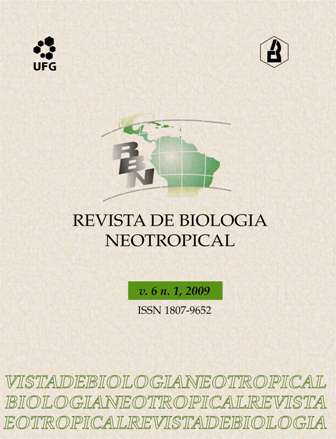Orchidaceae of the Parque Estadual da Serra de Caldas Novas, Goiás State, Brazil
Keywords:
Centris (Trachina) fuscata, Cyrtopodium eugenii, floristics, florivory, PESCANAbstract
In this study, we carried out a survey of the Orchidaceae species occurring at the State Park of Serra de Caldas Novas (PESCAN), as well as a study of the floral and reproductive biology of Cyrtopodium eugenii Rchb. f. & Warm. and the effect of floral herbivory on the reproductive success of this species, which occurs in the rocky fields of PESCAN. The Orchidaceae family consists of 850 genera, about 20,000 species, presents cosmopolitan distribution, but its greatest concentration is in the tropical region. In Brazil, 200 genera are found, with more than 2,500 species, and it is considered the third country in the world in diversity of orchids, only inferior to Ecuador and Colombia. In the Cerrado biome, this family is represented by 666 species, and 12 of them were found in PESCAN, distributed in seven genera. The most common habit of the species occurring in PESCAN is terrestrial and the predominant flowering season occurs in the rainy season. Only one species, C. eugenii, flowers in the dry season, from May to September, and is very common in PESCAN. In C. eugenii the flowers are pale yellow with brown spots, but the lip is bright yellow. In this study, the only pollinator species found for C. eugenii was Centris (Trachina) fuscata Lepeletier, 1841 (Anthophoridae, Centridini). Although C. eugenii offers no floral rewards tothe pollinator, its lip seems to mimic Tetrapterys ramiflora A. Juss. flowers, an oil producer Malpighiaceae with yellow flowers, and deceives the pollinator. As in other species without reward, C. eugenii receives few visits from the pollinator and, consequently, presents a low fruit production rate. This species is self-compatible, but no fruits were generated either by spontaneous self-pollination or agamospermy. Preliminary field observations revealed that C. eugenii inflorescences and flowers experience continuous florivory. Natural florivory quantification showed that 55.20% of the flowers were not consumed, while in 15.45% of them the sexual structures were consumed (florivory direct effects). We found more flowers with lip damage (20.50%) than with other petals and sepals damage (18.92%). A 88 manipulative experiment showed a significant decrease in C. eugenii reproductive success (male and female) only when florivory occurred in the lip (florivory indirect effects). This result indicates that the lip is the most important flower part to attract the pollinator and for C. eugenii reproduction, because although herbivory level was high in other floral parts, no significant decrease was observed in the reproductive success of this species.
Downloads
Downloads
Published
How to Cite
Issue
Section
License
The expontaneos submmition of the manuscript automaticaly implies in the cession of all patrimonial rights for the Journal of Neotropical Bilogy (RBN) after publication. The autor allow the right of first publication of the article to the RBN, under Creative Commons Attribution 4.0 (CC BY-NC 4.0) Licence.
There are garanties for the authors to the authorial and moral rights, for each one of the articles published by RBN, with permissions:
1. The use of article and contents for the education and researches.
2. The use of the article and their contents, linking to the Article on the web site of the RBN, allowing the divulgation on:
- institutional closed web (intranet).
- open access repositories.
3. Preparation and divulgation of the other publication derived from the article and its content, if there is citation of the original publication by RBN.
4. Make printed copies in small quatinties for personal use.

















